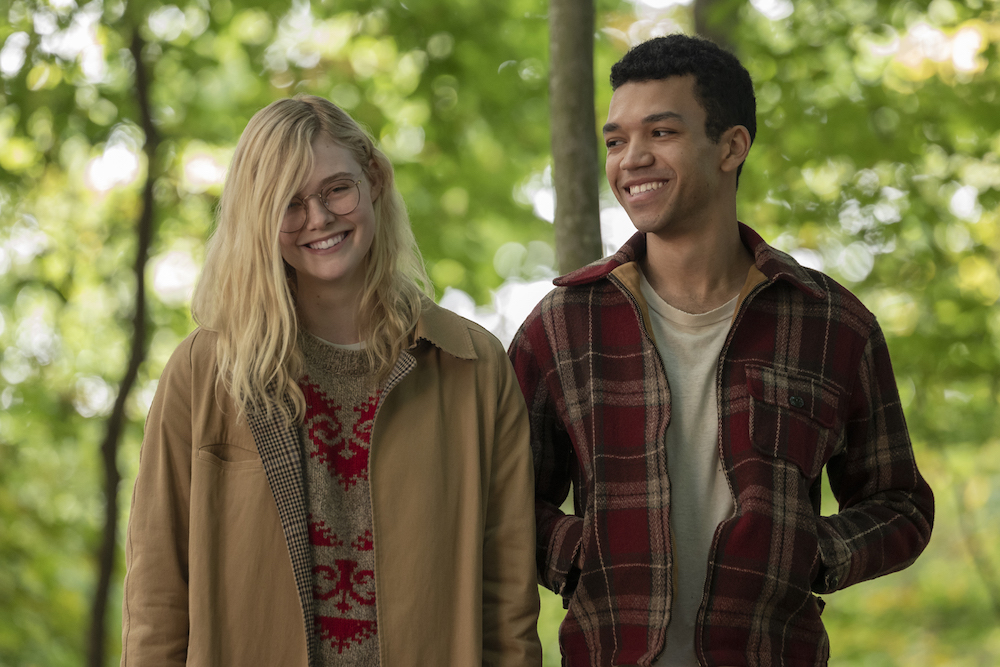‘All The Bright Places’: Film Review
By Courtney Howard
LOS ANGELES (Variety.com) – Director Brett Haley’s “All The Bright Places” may tackle a few dark issues, but this teen weepie about two hurting souls is drenched in warmth and compassion. Adapted by Jennifer Niven and Liz Hannah from Niven’s bestselling young adult novel, Haley’s feature contains all the necessary ingredients for success that films like “The Fault in Our Stars” and its ilk have — undeniably cute leads adept at conjuring cheers and tears, a solid soundtrack and a pass-the-tissues third act — yet its pure beating heart and humanistic undertones make it somewhat of a standout. That said, audiences might want to exercise some caution as content dealing with suicide, grief and mental health, while handled with an extremely sensitive touch, might be triggering for those who feel compromised.
While out running one morning, Theodore Finch (Justice Smith) spots classmate Violet Markey (Elle Fanning) silently contemplating jumping off a bridge. She’s been withdrawn and grief-stricken since the death of her sister a year prior. Finch hops up on the ledge, offering Violet a hand and an unspoken pledge that she is no longer alone in her struggle. He too can relate as he’s looking for reasons to stay alive, scribbling them down on a fleet of color-coded Post-Its that polka-dot his bedroom walls. Though the filmmakers never specifically nail down a clinical diagnosis, Finch’s apparent manic depression casts a long shadow over all aspects of his life. Finch’s erratic behavior — causing destruction and ditching class for elongated stints — at their high school has earned him the nickname “freak.”
Their lives change when their geography teacher assigns them a travelogue project that has the students wandering all over Indiana (Ohio stands in as the filming location), chronicling wondrous sights off the beaten path. The duo bond through these activities, logging local attractions like the highest point in the state, a backyard roller-coaster, a shoe-covered tree and an interpersonal chalk wall display. His affection encourages her to embrace life, while her presence provides him a tether to the living. However, as one of them ascends into the light, the other descends into a darker place.
Blessedly, characters don’t always respond in perfect postcard or predictable ways, which keeps things from traversing into afterschool special territory. Finch and Violet don’t do and say the exact right things when called for. It never crosses Finch’s mind that he shouldn’t give Violet a potential death scare when she’s already witnessed her sister perishing. Finch doesn’t verbalize his issues properly to people who could help, like his guidance counselor (Keegan-Michael Key) and older sister (Alexandra Shipp). Violet doesn’t bring her concerned dad (Luke Wilson) along when she’s frantically searching for Finch.
Still, the filmmakers take precautions to avoid manipulative devices. The shedding of tears may be unavoidable, but at least it’s earned catharsis. One of the subtler aspects of the storytelling is the context of their geography assignment, which is a metaphor for locating the sources of their pain and shining a light on those patches. It’s also refreshing that this doesn’t play out in expected ways with both characters fixing each other. Those sentiments aren’t healthy and true to real life. The filmmakers are interested in showing different facets of grief where one is able to heal and the other is lacking those same capabilities.
Violet’s inevitable emotional breakthrough is restrained in Fanning’s capable hands. Her joy and devastation are palpable. She’s in masterful control finding power in refinement. Smith makes for an equally captivating screen partner, as this plays like a showcase for his charisma, charm and vulnerability. His work is revelatory, considering we haven’t seen anything like this from him before. Together, they increase the intimacy and immediacy of the material.
There are scoops of sweetness in the beginning of Violet and Finch’s courtship that border on twee, but those give way to the kind of character-driven movements that elevate Haley’s previous features “Hearts Beat Loud,” “The Hero” and “I’ll See You in My Dreams.” The pair trade quotes from depressed writer Virginia Woolf as deep-thinking, introspective teens do. They dance in fields, celebrating their youthful spirits. Their impromptu staring contest is the prescribed manic pixie dreamboat moment of the entire piece. Luckily, that arrives early as the rest of the drama and romance blessedly remains grounded, honest and authentic.
Composer Keegan DeWitt’s propulsive suites oscillate between sonically stirring strings, light-as-a-feather wind instruments and simplistic piano chords. They provide the audible connection between the characters’ transient states of sadness and happiness. Because teen films have typically been driven by their soundtracks, this one, curated by music supervisors Joe Rudge and Chris Swanson, is loaded with indie rock artist discoveries that John Hughes would approve of. Even Starship’s cheesy ’80s ballad “Nothing’s Gonna Stop Us Now” sneaks in with a non-obnoxious cameo appearance.
Cinematographer Rob Givens’ saturated approach resounds in scenes that unabashedly embrace romantic overtones, basking the two leads in the warm glow of the golden hour, or the soft low light of their rainstorm smooch. It also stands strong in sequences where their emotions become cooler, rougher around the edges and more difficult to define. Suzy Elmiger’s cuts allow for the performers to guide the rhythm and flow of the scenes.
Still, “All The Bright Places” would be nowhere without Haley’s vision and deft ability to deliver all of the feels. He finds places to let his bright intellect shine, perfectly crafting heartrending melodrama through tonal pacing that’s never cloying nor disgustingly saccharine.

